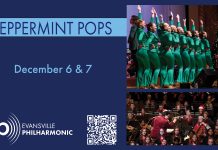Two Evansville built P-47s are making their way back home to visit during the P-47 Homecoming hosted by the Freedom Heritage Museum. On Saturday, July 6 veterans and their families are invited to view the P-47s and other military warbirds from 8-10:30am. Veterans will be served coffee and donuts and will have the opportunity to have their photo taken next to one of the P-47s. After the event a free download of the photographs will be available courtesy of the Courier and Press YourTurn photo gallery. Local historian and author, Harold B. Morgan, will be on hand to sign copies of his book, Home Front Warriors. To RSVP, please call (812)759-8186. Children must be 10+ and accompanied by an adult. The event will be held at the Bizal hanger which is located right next to Dairy Queen on Hwy 41 next to the airport. Streetside parking is available along with additional parking in the Dairy Queen lot.
Evansville Mayor Lloyd Winnecke has proclaimed July 6, 2013, “P-47 Homecoming Day†in Evansville. “The P-47 shows the magnitude of what Evansville can accomplish,†Mayor Winnecke stated. “It’s a perfect example of our ‘We are Evansville’ community pride campaign.†Special thanks to all the donors and community partners who have helped make the P-47 Homecoming possible. These include Alvey’s Signs, Central Library, Christian Fellowship Church, Donut Bank, Dr. John Bizal, Evansville Courier & Press, Forest Hills Baptist Church, M&K Photographic, Marine Moms of Evansville, Pinch of Sugar, and all the volunteers. Vice President Rick Kaskel said, “The vision for the museum was easy. Gaining the support is the next step.†To learn more about the Freedom Heritage Museum or to donate, visit www.freedomheritagemuseum.org .
The future Freedom Heritage Museum (FHM) is a not-for-profit museum located in Evansville, IN that is dedicated to providing all generations a glimpse into the role of Evansville’s manufacturing support during World War II. This is done through preservation of artifacts produced in the Evansville region and through the telling of the veterans’ and home front heroes’ stories. “Evansville played a major role in these world events,†says President Richard Litov, “and everyone was involved; it was our parents and grandparents.†Evansville was the most productive war materials manufacturing city in the world per capita during WWII.
Over 6,000 P-47 Thunderbolts were produced at the Republic Aviation plant in Evansville during World War II. Republic Aviation employed 8,300 local home front heroes who delivered an average of 10 P-47s per day. Of all the P-47s produced, approximately six are still flying today.
The Freedom Heritage Museum was established with the mission “to collect, preserve, and make accessible the objects produced and the personal accounts of our local home front and veteran heroes of World War II, so that future generations become educated about the efforts and sacrifices and that we remember and honor them for protecting the freedoms we have today. The museum was co-founded by President Richard Litov, Ph.D. and Treasurer, John Dunn.
The museum’s board of leaders include officers: President Richard Litov, Ph.D., Vice President Rick Kaskel, Treasurer John Dunn, and Secretary H.C. Bud Farmer, and board of directors: Dr. Joe Baylor, Dr. Steven Becker, Paul Black, J.D., Dr. Mark Browning, Jack Buttrum, Robert Myer, Bill Spurling, John Zeidler, and John L. Wright.
The future Freedom Heritage Museum will be located in a hangar at the Evansville Regional Airport. The museum will feature exhibits of the Evansville built
P-47 Thunderbolt, military vehicles, and production equipment. The museum will also
be dedicated to providing educational opportunities to the public through lectures, seminars, and digital storytelling of personal accounts of veterans and home front heroes.
The current collection of artifacts includes a 1944 North American Aviation SNJ-5 advanced trainer warbird, a Pratt & Whitney R-2800-59 radial engine from a P-47, a 1945 Willys MB Jeep, and industrial machines from the Republic Aviation Evansville plant, and various personal items from local veterans and home front workers. The artifacts have been donated or loaned to the Freedom Heritage Museum. The Freedom Heritage Museum and board of leaders looks forward to gaining community support to achieve the goal of creating a museum dedicated to honoring Evansville for its role during World War II.
* Over 6,000 P-47 Thunderbolts were produced during World War II at the Republic Aviation plant in Evansville, Indiana, more recently known as the Whirlpool Plant. Two of the approximately six P-47s that are still flying, will fly into Evansville and will be viewed by veterans and their families at the P-47 Homecoming event on Saturday, July 6 at the Bizal Hangar.
* During World War II, the “Greatest Generation,†Americans who joined the war efforts, came together to support the war by serving in the military, shifting manufacturing in the U.S. from consumer to war materials, women joined the workforce, and all endured personal sacrifices.
* In December 1943, Republic Aviation Corporation had the highest fighter production totals and Evansville has the highest rates in production efficiency. The first P-47 took nearly 23,000 hours to assemble. Production time was reduced to 6,300 hours per P-47 near the end of production.
* Republic Aviation of Evansville employed approximately 8,300 people. Shifts were 10 hours long with a two hour break in between to restock parts.
* The P-47 Thunderbolt is equipped with eight, .50 caliber, Browning machine guns. The women who assembled the 65 pound machine guns were known as “gun molls.â€
* P-47s produced in Evansville have a model number ending in “RA†while P-47s produced in Farmingdale, New York are identified by their model number ending in “RE.â€
* Ferry pilots were men and women pilots that flew the completed P-47s from Evansville to their next destination before combat. The Women Airforce Service Pilots (WASP) was a group of women ferry pilots. In early 1944, Evansville had an excess of 275 P-47s waiting to be “ferried.†These ferry pilots set a record in February 1944, moving 83 P-47s in one day.
* The P-47 was initially used to escort and protect U.S. bomber groups in Europe from enemy fighters, while en route on bombing missions. Later, they were used as fighter-bombers and ground support to attack enemy front lines and supply lines both in Europe and the South Pacific.
* At the end of production, 14 P-47s, lacking guns, radios, and wings, were given to schools and colleges in Indiana. The remaining P-47s were scrapped for a value of $125.
* The Freedom Heritage Museum is dedicated to preserving World War II artifacts that were produced in the Evansville region and telling the stories of our local veterans and home front heroes.
Specifications
Length: 36 feet 1 inch
Height: 14 feet 8 inches
Wingspan: 40 feet 9 inches
Empty Weight: 10,000 pounds
Loaded Weight: 17,500 pounds
Crew: 1
Maximum Speed: 433 mph
Range: 800 miles
The P-47 Thunderbolt, also known as “The Jug,†measured slightly over 36 feet long and nearly 15 feet tall, with a wingspan of just under 41 feet. The loaded weight of a P-47 was approximately 17,500 pounds. It could race across the sky at a maximum speed of 433 miles per hour within a range of 800 miles.
The aircraft gets its speed from the 2,100 horsepower, Pratt & Whitney R-2800-59 radial engine. The 2,400 pound engine was produced by Ford Motor Company and installed in all Evansville produced P-47s. Perhaps even more fascinating is the self-sealing fuel tank produced by Firestone Tire & Rubber Company. The fuel tank would seal closed after being punctured by enemy fire.
The P-47 was equipped with eight, .50 caliber machine guns, four in each wing. Each machine gun could hold up to 425 rounds of fire, weighing 1,000 pounds fully loaded. The single pilot of the aircraft could “bore sight†the machine guns to their preferred bullet pattern or “spreadâ€. The estimated force of the Thunderbolt’s machine guns has been compared to a 10,000 pound truck hitting an object at 60 miles per hour.
Two primary models of the P-47 were produced; first was the P-47-D model, produced from 1942 until June 1945, when the P-47-N model was introduced. The P-47-D “Razorback†featured an elongated cockpit, but was later replaced by a more rounded cockpit with better visibility, earning the name “bubbletop.†The “blond†model
received its name after painting P-47s ceased in early 1944 and would now bare their natural aluminum body. Finally, the P-47-N model was produced, improving its long distance range for missions anticipated for the invasion of Japan.
During World War II, Republic Aviation Corporation produced nearly all P-47 Thunderbolts. The main production site was located in Farmingdale, New York, and the secondary production site in Evansville, Indiana. In April 1942, Republic Aviation broke ground for the P-47 production plant in a field immediately south of the Evansville Airport on Highway 41. By this time, the airport had joined the war efforts by serving almost exclusively for military flights as needed by the US Army Air Corps.
Production began in October 1942 and assembly lines stayed busy as the nearly 8,300 total workers worked around the clock. Male and female workers produced instruments, control switches, metal fabrication, and many other parts. The P-47’s machine guns were assembled by a group of women, known as the “gun molls.†Two additional Evansville companies, Servel and Hoosier Cardinal, produced nearly 32,000 P-47 wings and 16,000 tail pieces. An additional plant at the airport, known as the Modification Center, was responsible for altering the standard P-47 for the Russian, Brazilian, and British Royal Air Forces along with other World War II aircraft such as the B-25 Mitchell Bomber.
Off the assembly line, the P-47s would be “ferried†to their destinations by male and female ferry pilots. The Women Airforce Service Pilots (WASP) was an organization of over 1,000 female ferry pilots. The P-47 was introduced in the European theater to escort and protect U.S. bomber groups, which were being badly attacked by enemy fighters. Later, they were used as fighter-bombers and ground support to attack enemy front lines and supply lines, both in Europe and the South Pacific. The P-47 was the first U.S. fighter plane during WWII to be equipped with a bomb.
As the war ended, Republic Aviation closed production in Evansville in late 1945. The buildings were purchased by International Harvester and later sold to Whirlpool-Seeger. However, it could not be forgotten that the two Republic Aviation plants together would produce the most fighter airplanes during World War II, providing critical support for the war.





Awesome information about about something significant built here at home!The planes and LSTs built in Evansville represent the great things that can be done when a community and, on a larger scale, the country comes together for a greater cause. Reminders like this are too few and far between these days.
Kudos to the Editors for this fascinating historical information. There is an amazing story about a P 47 pilot named Quentin Aanenson. If you can watch the series it shows just how valuable the P 47 was and how brave its pilots were. Truly the greatest generation.
http://quentinaanenson.com/
http://www.youtube.com/watch?v=7Fx9f-ccJu4
Great article. I wish we had a P47 plane located here to go with the LST.
This was a really interesting read. I enjoyed that a lot.
P-47 homecoming was outstanding. I personally met two POW’s, one of them a POW 3 times. Much to be thankful for and pray the museum will do them justice!
Im grateful for the article post.Much thanks again. Really Cool.
My Dad was a WWII fighter pilot that flew a P-47–36th Fighter Group/22nd Squadron.
I have his squadron book and have seen photos of his plane, but one day hope to see the magnificent P-47 in person.
Thank you for this article.
Comments are closed.